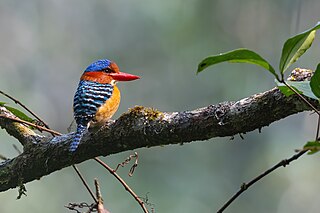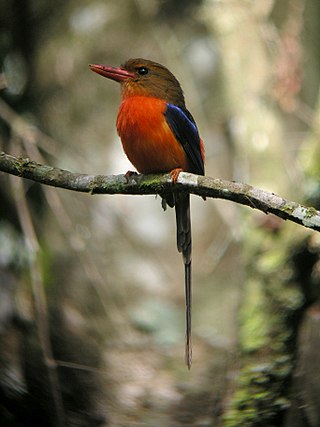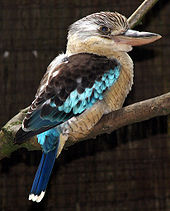
Kingfishers are a family, the Alcedinidae, of small to medium-sized, brightly coloured birds in the order Coraciiformes. They have a cosmopolitan distribution, with most species living in the tropical regions of Africa, Asia, and Oceania, but also can be seen in Europe. They can be found in deep forests near calm ponds and small rivers. The family contains 116 species and is divided into three subfamilies and 19 genera. All kingfishers have large heads, long, sharp, pointed bills, short legs, and stubby tails. Most species have bright plumage with only small differences between the sexes. Most species are tropical in distribution, and a slight majority are found only in forests.

The laughing kookaburra is a bird in the kingfisher subfamily Halcyoninae. It is a large robust kingfisher with a whitish head and a brown eye-stripe. The upperparts are mostly dark brown but there is a mottled light-blue patch on the wing coverts. The underparts are cream-white and the tail is barred with rufous and black. The plumage of the male and female birds is similar. The territorial call is a distinctive laugh that is often delivered by several birds at the same time, and is widely used as a stock sound effect in situations that involve a jungle setting.

The blue-winged kookaburra is a large species of kingfisher native to northern Australia and southern New Guinea.

The rufous-bellied kookaburra, originally known as Gaudichaud's kookaburra after French botanist Charles Gaudichaud-Beaupré, is a species of kookaburra that is widely distributed through the forests of lowland New Guinea.

The spangled kookaburra also called Aru giant kingfisher, is a little-known species of kookaburra found in the Aru Islands, Trans-Fly savanna and grasslands of southern New Guinea. Practically nothing is known of its family life or breeding biology.
Kookaburras are birds native to Australia and New Guinea, of the genus Dacelo.

The buff-breasted paradise kingfisher is a bird in the tree kingfisher subfamily, Halcyoninae. It is native to Australia and New Guinea. It migrates in November from New Guinea to its breeding grounds in the rainforest of North Queensland, Australia. Like all paradise kingfishers, this bird has colourful plumage with a red bill, buff breast and distinctive long tail streamers.

The shovel-billed kookaburra, also known as the shovel-billed kingfisher, is a large, approximately 33 cm (13 in) long, dark brown tree kingfisher with a heavy, short, and broad bill that is unique among the kingfishers. It has a dark head with a rufous stripe behind the eyes, a white throat, a rufous neck collar and underparts, a bright blue rump, brown iris, brownish-black bill with paler mandible, and pale feet. Both sexes are similar in appearance, but are easily recognized from the colour of the tail. The male has a dark bluish tail while female's is rufous. The juvenile has a female-like plumage with scale-patterned feathers.

The yellow-billed kingfisher(Syma torotoro) is a medium-sized tree kingfisher.

The banded kingfisher is a tree kingfisher found in lowland tropical forests of southeast Asia. It is the only member of the genus Lacedo. Male and female adults are very different in plumage. The male has a bright blue crown with black and blue banding on the back. The female has rufous and black banding on the head and upperparts.

The paradise kingfishers are a group of tree kingfishers endemic to New Guinea — with the exception of two species also present in the Moluccas and Queensland.

The moustached kingfisher, also called Bougainville moustached kingfisher, is a species of bird in the family Alcedinidae. It is endemic to Bougainville Island in Papua New Guinea. An estimated 250–1,000 mature individuals are left.

The hook-billed kingfisher is a species of kingfisher in the subfamily Halcyoninae that is resident in the lowland forested areas of New Guinea and some of the nearby islands. It is the only member of the genus Melidora.

The blue-black kingfisher is a species of bird in the family Alcedinidae. A medium-sized kingfisher of mangroves and forested streams in the lowlands. It is found in New Guinea and offshore islands of Salawati, Batanta and Yapen. It is considered rare and declining with threats being logging of lowland swamp forests and declining water quality.

The tree kingfishers, also called wood kingfishers or Halcyoninae, are the most numerous of the three subfamilies of birds in the kingfisher family, with around 70 species divided into 12 genera, including several species of kookaburras. The subfamily appears to have arisen in Indochina and Maritime Southeast Asia and then spread to many areas around the world. Tree kingfishers are widespread through Asia and Australasia, but also appear in Africa and the islands of the Pacific and Indian Oceans, using a range of habitats from tropical rainforest to open woodlands.

Australia Walkabout Wildlife Park is a wildlife sanctuary located in Calga, New South Wales, Australia. The wildlife park is home to Australian native birds, mammals and reptiles as well as farm animals. It offers research and education programs, with visitors able to undertake day and night tours. The park is home to a wide range of Australian animals and in 2021 became home to a group of meerkats, the park's first exotic animals.































